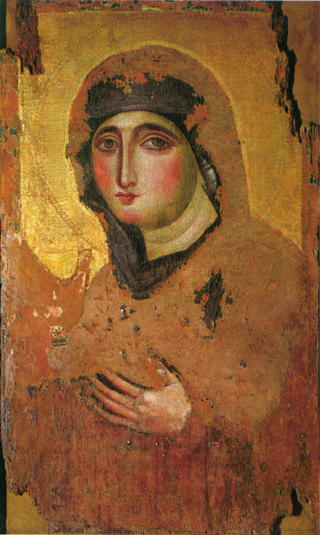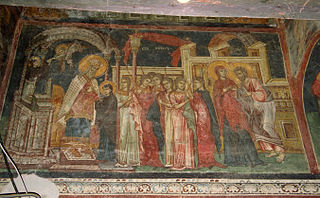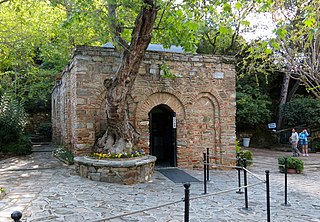
Emerentia [1] is the name given for a grandmother of Mary, mother of Jesus, in some European traditions and art from the late 15th century. [2] She is not to be confused with Saint Emerentiana, a Roman martyr of the 3rd century.

Emerentia [1] is the name given for a grandmother of Mary, mother of Jesus, in some European traditions and art from the late 15th century. [2] She is not to be confused with Saint Emerentiana, a Roman martyr of the 3rd century.
There is no reference to the grandmother of Mary, by name or otherwise, in the canonical New Testament or the Protoevangelium of James, which is the earliest source naming Saint Joachim and Saint Anne as the parents of Mary.
Stories about Anne form part of Jacobus de Voragine's Legenda Aurea , but her mother is not mentioned. An early source mentioning Emerentia, is Josse Bade's (Jodocius Badius Ascensius, 1461–1535) 1502 translation of Petrus Dorlandus' work Vita gloriosissime matris Anne contained in the larger compilation Vita Iesu Christi ... ex evangelio et approbatis ab ecclesia catholica doctoribus sedule collecta per Ludolphum per Saxonia (published in Paris), which tells the story:
Seventy seven years before the birth of Christ, a pious maiden, quite well off and remarkably beautiful, was in the habit of visiting, with her parents' permission, the sons of prophets on Mount Carmel. She was disinclined to marriage, until one of the Carmelites had a prophetic dream, they saw a root from which grew two trees, one had three branches, all bearing flowers, but one a flower more pure and fragrant than all the rest ... Then a voice was heard saying: "This root is our Emerentia, destined to have great descendants. [3]
Another source is Johann Eck, who related in a sermon that Anne's parents were named Stollanus and Emerentia. [4]
Emerentia appears in a number of depictions of the Holy Kinship, the pictorial and sometimes sculptural [5] depiction of the ancestors and descendants of St Anne by many artists around the end of the 15th and beginning of the 16th century in Northern Europe. [6] Where Emerentia is featured in these groupings, which were often altarpieces, they are known as "Emerentia Selbviert". [7] These rare examples of a matrilineal genealogy of Jesus have been found interesting by modern academics in the field of gender studies, [8] and in feminist critiques of English literature, for example, Vanita argues that the feminine 'trinity' of Mary, her mother Anne and her grandmother Emerentia is reflected in two of Shakespeare's plays. [9]
In The Life of the Blessed Virgin Mary From the Visions of Anna Catherine Emmerich (posth. 1852) Emerentia is known as "Emorun," [10] [ page needed ] Emorun translates as "noble woman". [11] Emmerich describes in her visions how Emerentia lived as one of the Essenes, a particularly devout wing of the Jewish faith that believed it was destined to produce the Messiah, near Mount Carmel, and relates the story of how a prophet, entering the Cave of Elijah, saw the following growing from Emerentia's heart:
a rose tree with three branches, with a rose on each of them. The rose on the second branch was marked with a letter, I think an "M." He saw still more. An angel wrote letters on the wall; I saw Archos rise up as if awaking and read these letters. I forget the details. He then went down from the cave and announced to the maiden who was awaiting his answer that she was to marry and that her sixth suitor was to be her husband. She would bear a child, marked with a sign, who was chosen out of a vessel of election in preparation for the coming of the Savior. [12]

Mary was a first-century Jewish woman of Nazareth, the wife of Joseph and the mother of Jesus. She is a central figure of Christianity, venerated under various titles such as virgin or queen, many of them mentioned in the Litany of Loreto. The Eastern and Oriental Orthodox, Church of the East, Catholic, Anglican, and Lutheran churches believe that Mary, as mother of Jesus, is the Mother of God. Other Protestant views on Mary vary, with some holding her to have lesser status.

According to apocrypha, as well as Christian and Islamic tradition, Saint Anne was the mother of Mary, the wife of Joachim and the maternal grandmother of Jesus. Mary's mother is not named in the Bible's canonical gospels. In writing, Anne's name and that of her husband Joachim come only from New Testament apocrypha, of which the Gospel of James seems to be the earliest that mentions them. The mother of Mary is mentioned but not named in the Quran.

Anne Catherine Emmerich was an Roman Catholic Augustinian canoness of the Congregation of Windesheim. During her lifetime, she was a purported mystic, Marian visionary, ecstatic and stigmatist. She was born in Flamschen, a farming community at Coesfeld, in the Diocese of Münster, Westphalia, Germany, and died at age 49 in Dülmen, where she had been a nun, and later become bedridden. Emmerich purportedly experienced visions on the life and passion of Jesus Christ, as revealed to her by the Blessed Virgin Mary under religious ecstasy.

In the New Testament, Salome was a follower of Jesus who appears briefly in the canonical gospels and in apocryphal writings. She is named by Mark as present at the crucifixion and as one of the Myrrhbearers, the women who found Jesus's empty tomb. Interpretation has further identified her with other women who are mentioned but not named in the canonical gospels. In particular, she is often identified as the wife of Zebedee, the mother of James and John, two of the Twelve apostles. In medieval tradition Salome was counted as one of the Three Marys who were daughters of Saint Anne, so making her the sister or half-sister of Mary, mother of Jesus.

The Presentation of the Blessed Virgin Mary, known in the East as The Entry of the Most Holy Theotokos into the Temple, is a liturgical feast celebrated on November 21 by the Catholic, Eastern Orthodox, and some Anglo-Catholic Churches.

The Nativity of the Blessed Virgin Mary, the Nativity of Mary, Marymas or the Birth of the Virgin Mary, refers to a Christian feast day celebrating the birth of Mary, mother of Jesus.

The House of the Virgin Mary is a Catholic shrine located on Mt. Koressos in the vicinity of Ephesus, 7 kilometres (4.3 mi) from Selçuk in Turkey.

Our Lady of Mount Carmel, or Virgin of Carmel, is the title given to the Blessed Virgin Mary in her role as patroness of the Carmelite Order, particularly within the Catholic Church. The first Carmelites were Christian hermits living on Mount Carmel in the Holy Land during the late 12th and early to mid-13th century. They built in the midst of their hermitages a chapel which they dedicated to the Blessed Virgin, whom they conceived of in chivalric terms as the "Lady of the place." Our Lady of Mount Carmel was adopted in the 19th century as the patron saint of Chile.

The Madonna and Child with St. Anne or Madonna and the Serpent, is one of the mature religious works of the Italian Baroque master Caravaggio, painted in 1605–1606, for the altar of the Archconfraternity of the Papal Grooms in the Basilica of Saint Peter and taking its theme from Genesis 3:15. The painting was briefly exhibited in the parish church for the Vatican, Sant'Anna dei Palafrenieri, before its removal, due to its unorthodox portrayal of the Virgin Mary. There are a lot of reasons why the piece may have been removed, such as the nudity of the child Jesus and the Virgin Mary revealing too much of her breast. The reputation of the model that Caravaggio used to portray the Virgin Mary could be another reason as to why this altarpiece was withdrawn. The altarpiece was sold to Cardinal Scipione Borghese and now hangs in his palazzo.

Flores de Mayo is a festival held in the Philippines in the month of May. It is one of the May devotions to the Blessed Virgin Mary and lasts for the entire month.

The Three Marys are women mentioned in the canonical gospels' narratives of the crucifixion and resurrection of Jesus. Mary was the most common name for Jewish women of the period.
Mary of Saint Peter was a Discalced Carmelite nun who lived in Tours, France. She is best known for starting the devotion to the Holy Face of Jesus which is now one of the approved Catholic devotions and for the The Golden Arrow prayer. She also introduced the "Little Sachet" sacramental.

The Holy Kinship was the extended family of Jesus descended from his maternal grandmother Saint Anne from her trinubium or three marriages. The group were a popular subject in religious art throughout Germany and the Low Countries, especially during the late 15th and early 16th centuries, but rarely after the Council of Trent. According to medieval tradition, Saint Anne, the mother of the Virgin Mary, was grandmother not just to Jesus but also to five of the twelve apostles: John the Evangelist, James the Greater, James the Less, Simon and Jude. These apostles, together with John the Baptist, were all cousins of Jesus.

Mary, the mother of Jesus in Christianity, is known by many different titles, epithets, invocations, and several names associated with places.
This article lists the feast days of the General Roman Calendar as approved on 25 July 1960 by Pope John XXIII's motu proprioRubricarum instructum and promulgated by the Sacred Congregation of Rites the following day, 26 July 1960, by the decree Novum rubricarum. This 1960 calendar was incorporated into the 1962 edition of the Roman Missal, continued use of which Pope Benedict XVI authorized in his 7 July 2007 motu proprio Summorum Pontificum, and which Pope Francis updated in his 16 July 2021 motu proprio Traditionis custodes, for use as a Traditional Roman Mass.

Throughout history, Catholic Mariology has been influenced by a number of saints who have attested to the central role of Mary in God's plan of salvation. The analysis of Early Church Fathers continues to be reflected in modern encyclicals. Irenaeus vigorously defended the title of "Theotokos" or Mother of God. The views of Anthony of Padua, Robert Bellarmine and others supported the doctrine of the Immaculate Conception of the Virgin Mary, which was declared a dogma in 1850.
Sobe, also known as Sovin, was the mother of St. Elizabeth and sister of St. Anne.

The Virgin and Child with Saint Anne or Madonna and Child with Saint Anne is a subject in Christian art showing Saint Anne with her daughter, the Virgin Mary, and her grandson Jesus. This depiction has been popular in Germany and neighboring countries since the 14th century.
Mysterii Paschalis is an apostolic letter issued motu proprio by Pope Paul VI on 14 February 1969. It reorganized the liturgical year of the Roman Rite and revised the liturgical celebrations of Jesus Christ and the saints in the General Roman Calendar. It promulgated the General Roman Calendar of 1969.